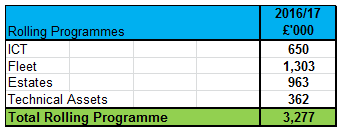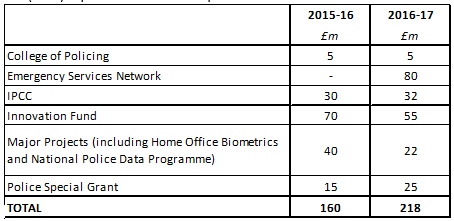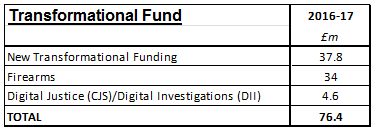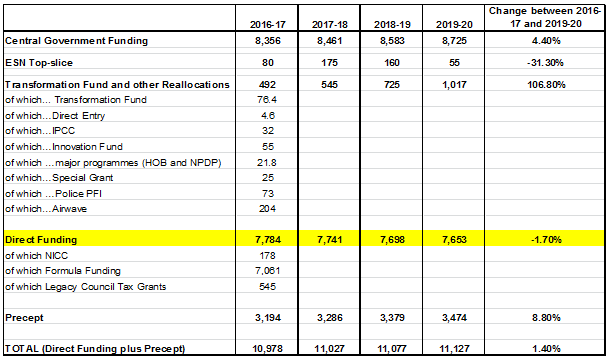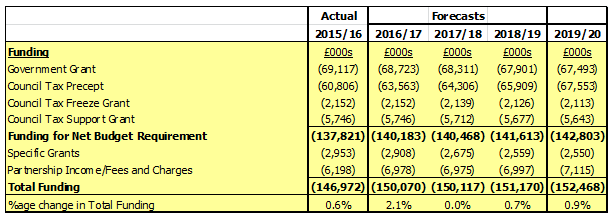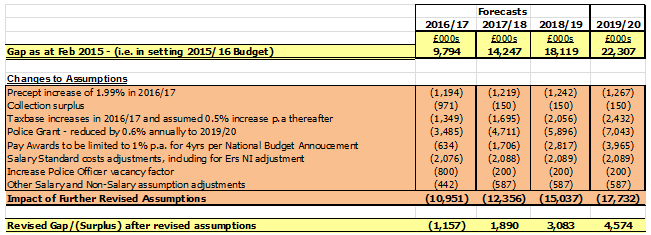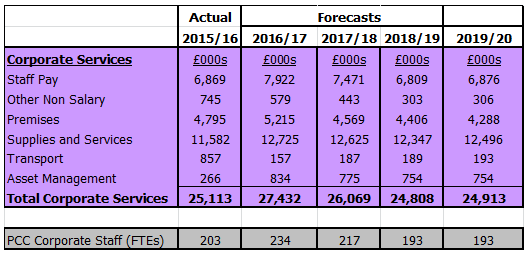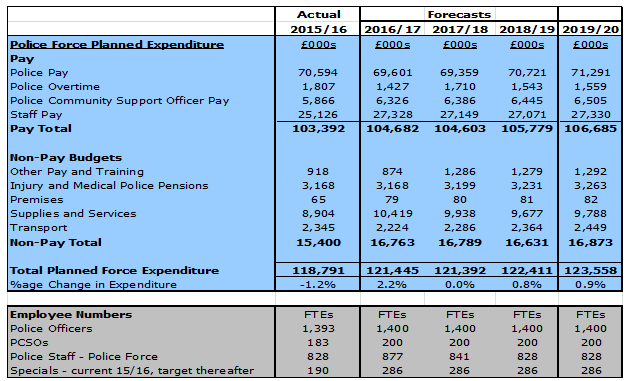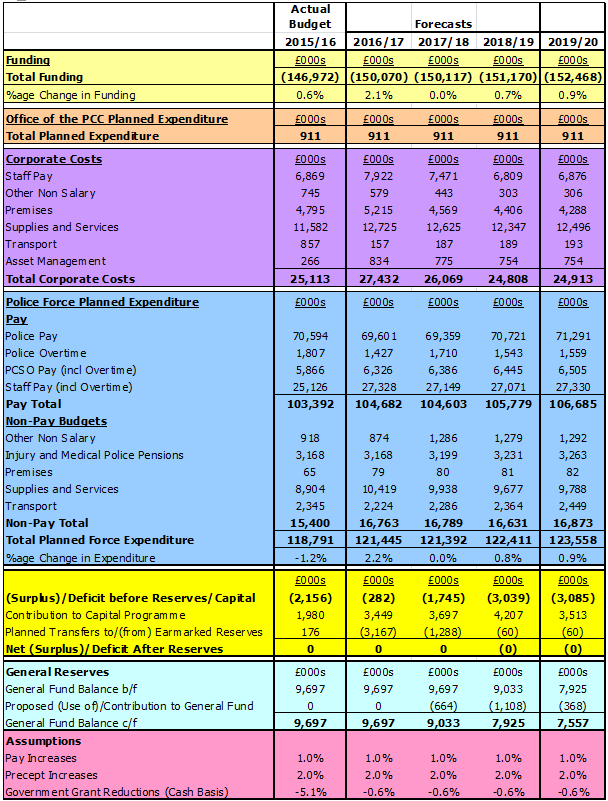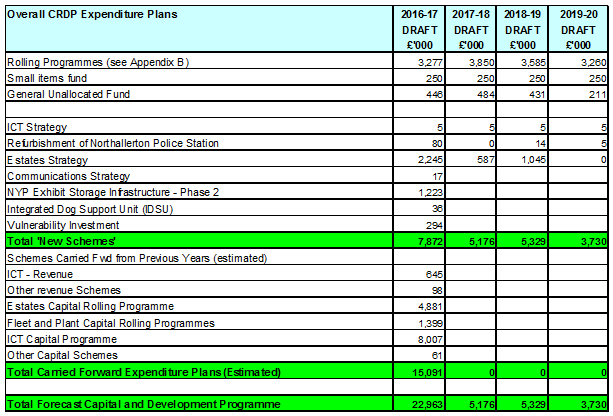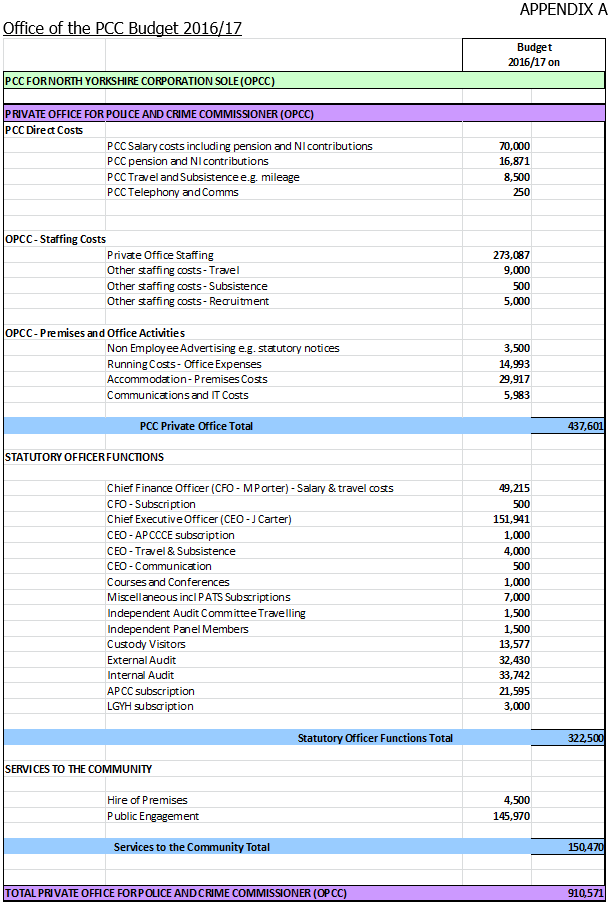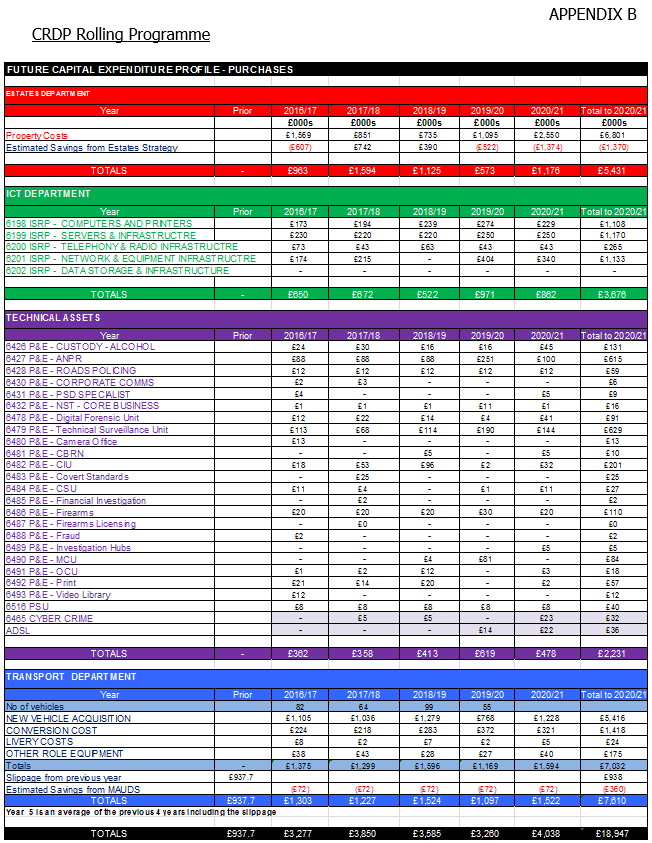07/2016: 2016/17 Budget: Medium Term Financial Plan 2016/17 to 2019/20 and Capital Plans 2016/17 to 2019/20 – 25 February 2016
Executive Summary and Recommendation:
This is a Decision Notice outlining the Commissioner’s Budget and Capital Plans for 2016/17 and the Medium Term Financial Plans to 2019/20.
There is a legal requirement for the PCC to set a budget prior to the 1st March each year for the following financial year. Approving this Decision Notice will ensure that the PCC’s obligations in this area are met for 2016/17.
The Revenue Budget for 2016/17 is based on the approved 1.99% increase in precept for 2016/17 and sets out how the £150,070k of revenue funding to be received by the PCC in 2016/17 will be spent. The decision notice also sets out a capital and revenue development programme of nearly £23m for 2016/17 and provides details of how this will be spent.
It is recommended, by the Commissioners Chief Finance Officer, that the Commissioner approves the Budget and Capital Plans for 2016/17 as set out in this Decision Notice along with the Medium Term Financial Plans to 2019/20. In approving this decision the Commissioner is agreeing to the allocation of resources set out within this decision and the associated appendices, and also the detailed recommendations in section 2 of this decision notice.
Decision
Police and Crime Commissioner decision: Approved
Signature: 
Date: 25 February 2016
Title: Police and Crime Commissioner
1. Introduction and Background
1.1 Purpose of the Report
This report asks the PCC to agree the Budget proposals for 2016/17 and the Medium Term Financial Plan (MTFP) for 2016/17 – 2019/20 in line with the legal requirement to set a budget prior to the 1st March each year for the following financial year. It also asks the PCC to agree the funding for the Capital and Revenue Development Programme for 2016/17 and the indicative allocations for the period 2017/18 to 2019/20.
2. Recommendations
2.1
The PCC is requested to approve the allocation of the £150,070k of revenue funding, that is forecast to be received by the PCC in 2016/17, in the following areas:
- £911k to run the Office of the PCC (see Appendix A)
- £27,432k for Corporate Services
- £121,445k to the Police Force
- £3,449k to the Capital Programme
- £3,167k from Reserves
2.2
The PCC is asked to note that the 2016/17 budget is based on the approved 1.99% increase in precept for 2016/17.
2.3
The PCC is asked to take cognisance of the Robustness of Estimates and Adequacy of Financial Reserves Report of the PCCs CFO that was discussed prior to this report.
2.4
The PCC is asked to agree that quarterly updates to the MTFP forecast will be brought to the PCC in 2016/17 to provide an update on the progress to deliver against this plan and to keep the PCC updated on changes to the plans.
2.5
The PCC is asked to agree that quarterly updates on the 2016/17 budget will be brought to the PCC in 2016/17 to provide updates on performance against the 2016/17 budget.
2.6
In order to implement the Capital and Revenue Development Programme (CDRP) and facilitate incurring and management of the expenditure, the following approvals are requested:
a. Approval of the 2016/17 Rolling Programme budgets, totalling £3,277k as set out below and detailed in Appendix B.
b. Approval of the small items fund of £250k for 2016/17, to be managed as set out in the Financial Regulations by the Chief Constables Chief Finance Officer.
(c)Indicative approval of the 2017/18 Rolling Programme budgets as set out in Appendix B, and delegation of approval of any requests to pre-order against the 2017/18 budgets to the Commissioners Chief Finance Officer, up to 25% of each indicative budget. The 2017/18 Rolling Programmes will be submitted for formal approval at this time next year.
d. Delegation to the Commissioners Chief Finance Officer to approve, where needed and appropriate, for the carry forward of any slippage from the approved 2015/16 CRDP into 2016/17.
3. Planning and Funding Assumptions
3.1 National budgets
Since the 2015/16 Budget was set by the PCC there have been 2 National Budgets, the first prior to the General Election in March 2015 and the second in July 2015. The key areas in terms of financial planning and budgeting of these Budgets have been previously reported.National Budgets
3.2 Comprehensive Spending Review
On 25 November 2015 the Chancellor of the Exchequer, George Osborne MP, announced the outcome of the Spending Review 2015. The Spending Review (SR2015) details spending settlements for each government department over the next four years (2016-17 to 2019-20). The SR2015 documents set out the announcements in more detail.
3.3
In his speech, the Chancellor addressed police funding and said: “now is not the time for further police cuts, now is the time to back our police and give them the tools to do the job.”
3.4
The key SR2015 announcements for police were that ‘overall police funding, including funding for Counter Terrorism, has been cut by 1.3% in real terms over four years’. In a letter to PCCs and Chief Constables the Home Secretary and Policing Minister said that “taking into account the scope that you have to raise local council tax, this means a flat real settlement for policing as a whole.
3.5 The 2016/17 Police Funding Settlement
The Provisional 2016-17 Police Finance Settlement was announced in a written ministerial statement by the Minister for Policing, Criminal Justice and Victims Mike Penning on Thursday 17 December.
3.6 Headlines
Mike Penning’s statement announced a flat rate reduction in grant funding of 0.6% in cash terms for 2016/17 which equates to a cash reduction of £394k for North Yorkshire. The headline from the Home Office is that no PCC will face a cash reduction in Formula Funding plus legacy council tax grants plus precept income, as long as they increase their precept by as much as they can. For North Yorkshire this was 1.99%.
3.7
As expected, this provisional settlement covered just one year and confirmed the previously-announced council tax flexibility whereby the 10 Policing Areas with the lowest Band D precept level can increase their Band D precept by £5. North Yorkshire is not one of these areas.
3.8
Top-slices have reduced to £218m in 2016-17. However, the Home Office have also introduced a new Transformational Fund worth £76.4m in 2016-17 to fund, amongst other things, firearms.
3.9
Legacy Council Tax funding is still separately identifiable and has increased slightly (£4.2m) in 2016-17 to include the 2015-16 Freeze Grant allocations.
3.10
There has been no obvious action taken on reserves with no mention of them at all in the written ministerial statement.
3.11
The provisional settlement announced that Police Capital Grant would reduce from £120m, of which £10m was allocated to NPAS), in 2015-16 to £82m, with £16.5m allocated to NPAS, in 2016-17. However the final settlement reduced the amount allocated to individual PCC’s by a further £10.4m. Therefore the amount allocated to North Yorkshire reduced by £332k, or 40%.
3.12 Council Tax Legacy Grants
In 2015-16 legacy council tax freeze grants as well as the council tax support grant were both separately identifiable in the settlement. During the funding formula review consultation process the Home Office consulted on their preference that these grants be rolled into the main settlement. Mike Penning’s statement confirms that they will remain separately identifiable.
3.13
The overall pot of Council Tax Legacy grants has increased slightly from £503m in 2015-16 to £514m in 2016-17 to include the (£4.2m) allocations made for 2015-16 Freeze Grant.
3.14
Mike Penning’s statement confirms that there will be no council tax freeze grants scheme for decisions made in 2016-17.
3.15 Counter Terrorism
The Spending Review also announced an additional £500m of funding, by the end of this parliament, for the Home Office, including a “real terms increase to the Counter Terrorism Policing Grant”.
3.16
In 2015-16 Police Counter Terrorism Grant allocations were worth £564m, the 2016/17 statement increases that funding to £640m with a further £30m to allocate in capital funding. This represents an increase of 13%.
3.17
Individual allocations have not yet been announced.
3.18 Top-Slices/Re-allocations
The Minister’s statement states that in 2016-17 the Home Office will ‘only’ be making reallocations of £218m, see the table below. However, it is worth keeping in mind that the £9.4m HMIC (PEEL) top-slice has become a permanent transfer.
3.19 Transformational Fund
The new Transformational Fund provides funding “to develop and deliver specialist capabilities such as those required to tackle cyber-crime and other emerging changes in crime, and enable a major uplift in firearms capability and capacity so that we can respond quickly and forcefully to a firearms attack”.
3.20
£76.4m has been allocated to this Fund for 2016/17 and is broken down as follows although it is not clear how this funding will be either accessed or allocated at this stage.
3.21 Emergency Services Network (ESN)
Emergency Services Mobile Communications Projects (ESMCP but also referred to as Emergency Service Network; ESN) is the replacement for Airwave. In a letter from Mary Calam dated 8 December 2015 she explains that included within the Chancellor’s real terms protection for Police Funding is the Police service’s share of the £1bn costs of ESMCP. Of the £400m potential savings, £260m are expected to accrue to the Police. Applying these same ratios the police share of the £1bn should be approximately £650m. The provisional settlement did not clarify the Police share of the £1bn although some further details were provided with the final settlement figures on the 4th February 2016 and further information on the financial implications of this significant investment is beginning to be shared.
3.22
Once this funding has been top-sliced away from the police settlement it will then be reallocated through specific grants to individual forces.
3.23
The ESN core costs will also be top-sliced from the settlement and then paid for centrally by the Home Office. In 2016-17 this top-slice is worth £80m. Included within this £80m top-slice is an estimate of the costs of upgrading control room, which the Home Office then plan to reissue as specific grants to the relevant force area as the costs fall due.
3.24
During and after transition force areas will pay local ESN costs, including for data and connection charges, devices and installation, and control room upgrades, supported by specific grants as set out above.
3.25
Existing Airwave costs will also be “brought into the police funding settlement from 2016-17”. This funding has also been top-sliced from the settlement, worth £204m, and paid for by the Home Office.
3.26
Individual force areas will continue to pay Airwave menu and other related local costs until the transition to ESN.
3.27 Ministry of Justice (MoJ) Funding
The Victim’s Funding comes from the MoJ. In the 2015 Spending Review the Chancellor announced a slight increase in revenue funding for the MoJ in 2016-17 but an overall resource saving of 15% by 2019-20. The individual allocations to PCC’s are expected ‘imminently’ but have not yet been released. At this stage the financial plan assumes no change from the funding received in 2015/16.
3.28 Innovation Fund
In 2016-17 the total is £55m, less than the £70m in 2015-16. Of this £55m approximately £20m has already allocated under previous years’ bids.
3.29 The Final Settlement
The final Police settlement confirmed the resource funding figures published at the provisional settlement. However as mentioned earlier there was a further top-slice from Police Capital worth £10.4m for Police National Technology Services.
3.30
The final settlement also provided some indicative figures for future years and these are shown in the table below:
3.31
The ‘Direct Funding’ line, which is the amount that is directly allocated to PCC’s as part of the overall Government Grant, is showing overall reductions of 0.6% per annum, which is in line with the forecast reductions within the MTFP. In addition the table also shows how the other reallocations and ESN funding have been taken into account within the overall funding envelope for Policing and as such the 0.6% reductions should be a relatively robust forecast.
3.32 Funding Formula
The Government has previously announced that ‘The postponement (of the funding formula review from implementation in 2016/17) will allow us to work with all police and crime commissioners and chief constables to identify the next steps and to ensure that we can deliver a reformed funding formula that all in policing can support.’
3.33
As a result of the review and the expectation that the work will result in a significantly different approach to the allocation of funding within policing the current assumptions with the financial plans do not factor in any adverse impact of a revised funding formula.
3.34
It is important to recognise that had the proposed ‘Simplified’ Funding Formula been in place for 2015/16 then based on the calculation done by Devon and Cornwall, who brought the error in the Home Office’s calculation to light, North Yorkshire would have received around £9m less funding.
3.35
Until there is clarity in relation to this area it remains a significant risk to the financial plans of the organisation and one that will need to be closely monitored going forward. The potential impact on the expenditure plans and service delivery plans of reductions of the order of £9m would be significant.
3.36 MTFP Funding Assumptions
Based on the information now provided to PCC’s the assumptions in relation to reduction in Government Grant have been revised to reflect the final settlement for 2016/17 and the indicative figures for future years. The assumption for the next 4 years, including 2016/17, is therefore that the level of Government Grants will reduce by 0.6% per annum.
3.37
These changes in assumption, that have occurred over the last few months, coupled with the inclusion in the current financial forecast that there will be no detrimental impact to the level of funding received by North Yorkshire, as a result of any new funding formula, has had a significant impact on the forecast levels of Government Grant to be received over the next 4 years. The table below summarises the current forecasts:
3.38
As can be seen from the above the revised forecasts assume that we will receive less Government Grant funding in each of the next 4 years in comparison to the previous years. These reductions are however not as high as previously forecast and not as high as those experienced in previous years.
3.39
It is important to note that in the 6 years to 2016/17 Government Grants have reduced by nearly £19m (or 21%) in cash terms and in real terms by nearly £28m (or 31%).
3.40 Precept
Around 45% of the Net Budget Requirement within North Yorkshire is funded by the local precept and therefore this will provide more of a cushion to cuts in government grants than in most Police Force areas.
3.41
The assumption throughout this plan, for planning purposes, is that this element will continue to increase at a rate of 1.99% per annum, although this will be subject to an annual decision.
3.42
The Government have informed PCC’s that ‘You should plan on the basis that the overall referendum limit for police precept will be maintained at 2% over the Spending review period for Police and Crime Commissioners in England.’ Therefore the risk in relation to this assumption going forward is manageable locally and subject to local decision and consultation annually.
3.43
Over the last 3 years there have been significant increases in both the number of calculated Band D properties within North Yorkshire and also significant Collection Surplus’ to which the PCC has benefited from.
3.44
In line with Government projections and based on historic trends the financial plans now include a 0.5% increase in the underlying tax base on an annual basis.
3.45
In the 6 years prior to the Localisation of Council Tax benefits, the overall surplus on the collections funds of the 8 Councils within North Yorkshire, average just under £140k per annum. In 2014/15 the collection surplus increased to £385k, in 2015/16 this increased to £757k and in 2016/17 it has increased again to £971k.
3.46
This results, in part, from more information now being available on the impact of the Localisation of Council Tax benefit scheme, the implementation of new powers on council tax and tax base growth. There is however no guarantee that this level of surplus will continue into future years and therefore the current financial plans assume a surplus on the collective collection funds of £150k per annum across the eight councils.
3.47
Based on the most up to date information and the revised planning assumptions the current forecasts around the funding for precept for the next 4 years, in comparison to 2015/16, are as follows:
3.48 Specific Grants, Other Income and Community Safety Grant
While the main government grant and money related to precept provide the PCC with the majority of its funding there are other areas from which the PCC will receive income. The assumptions in relation to this area build on the experience of the last 2 years and expected changes.
3.49
In terms of Specific Grants the PCC is forecast to receive between £2.5m and £2.9m per annum for the life of this plan. They are called specific grants as there is a requirement to spend them on the areas for which they are granted for. The vast majority of this funding relates to Victim and Witnesses grant from the Ministry of Justice and National Security funding.
3.50
Other funding is generated from a variety of sources such as secondments, interest on balances held and invested, collaboration contributions, special services income and speed awareness income.
3.51
These sources of income and funding are forecast to provide between £6.9m and £7.1m across the life of the plan.
3.52
The entire funding therefore expected to be available to the PCC for the next 4 years in comparison to 2015/16 is as follows
3.53
The current proportion of the ‘Government Grant’ funding that is reducing, equates to 46% of the overall income forecast to be received by North Yorkshire in 2016/17. Local precept currently makes up 42% of the overall funding.
3.54
Precept makes up a higher proportion of the overall funding received by North Yorkshire than most Policing Areas and therefore the impact of the reductions in Government funding is to some extent mitigated by this source of funding.
4. Affordability Programme
4.1
The Affordability Programme has been established to look at how we can shape the organisation and the operations to deliver the right service to the public of North Yorkshire within the budgetary constraints.
4.2
While some of the budgetary constraints may have eased in the last couple of months a significant amount of work has been done that should continue. These will make the organisation more effective and efficient which can then free up resources and money to invest in other priority areas in line with the Police and Crime Plan.
4.3
When the 2015/16 budget was set in February 2015 the projected Savings Gap was as per the table below:
4.4
Underpinning these forecasts were the following assumptions:
- Pay Awards: 2% increase p.a
- Precept: Freeze in 2016/17 and then increases of 1.99% thereafter
- No Tax Base increases and No Collection Surplus
- Grant Reductions: -5.4%, -2.5%, -2.5%, -2.5%
- Inflation: 2.5% for most areas, 5% for Utilities, Petrol and Rates
4.5
Since February 2015 these assumptions have changed significantly and the current MTFP is based on the following assumptions:
- Pay Awards: 1% increase p.a
- Precept: Increases of 1.99% per annum
- Tax Base increases 0.5% per annum, Collection Surplus £150k p.a
- Grant Reductions: -0.6%, -0.6%, -0.6%, -0.6%
- Inflation: 1.25% for most areas, 2.5% for Utilities, Petrol and Rates
4.6
The impact that these changes to assumptions, and other changes in assumptions have had on the projected ‘Gaps’ across the financial plan is significant and is summarised in the table below:
4.7
As can be seen from the above the forecast Gap has reduced by nearly £18m across the 4 years as a result of the changes to the assumptions that underpin the financial plans, with the forecast deficit in 2016/17 being completely eliminated.
4.8
As mentioned previously the Affordability Group has been meeting and working throughout the year to develop the savings plans that the organisation needed to balance its previously projected gap. The work of this group, along with the investments made elsewhere within the organisation have identified a significant amount of savings. In addition to this there are some unavoidable costs that the organisation will incur in the coming years. The delivery of these savings when combined with the changes in assumptions have had a significant impact on the projected financial position of the organisation as set out in the table below:
4.9
As can be seen from the above the impact of the better than expected funding settlement, lower than expected pay and non-pay inflation costs, combined with continued strong growth of the local tax base and the significant savings plans of the organisation has created the opportunity and capacity for targeted investment, to deliver improved services and deliver against the Police and Crime Plan objectives.
4.10
It is important to keep in mind that these projections assume that North Yorkshire will not lose any funding as a result of any revised Funding Formula.
4.11 Investing in the Police and Crime Plan Priorities
The research conducted with North Yorkshire residents, backed up by analysis from a range of sources identified four clear priorities supported by three corporate priorities.
4.12 Protect Vulnerable People
This was the ‘most important’ area identified during this initial research and it is also the area that is going to receive significant additional investment into based on this financial plan.
4.13
The plan is to tackle vulnerability, and enhance NYP’s ability to protect people in their own homes, as well as out in the community.
4.14
Over the next two years, the plan is to take on this challenge, by investing around £3m to:
- Expand the Serious Crime Team
- Expand the Integrated Offender Management Team
- Expand the Digital Forensics Unit to increase the ability to undertake forensic examination of devices such as computers, iPads and smartphones
- Create a Historical Child Abuse Investigation Team to investigate allegations of historical sexual abuse
- Enhance capabilities in online fraud and cybercrime, building on the investments that have already made in this area of increasing demand.
4.15
As well as resourcing the teams that deal with vulnerability, the plan is to also boost the level of welfare support and training offered to officers and staff who operate in this challenging area of business, in recognition of the pressures with this type of work.
4.16 Cut Crime and Anti-Social Behaviour
The financial plan includes enough funding to increase the number of PCSOs to 200 FTEs, an increase of 17 FTEs to invest further into neighbourhood policing teams. The expected efficiency savings from the investment in Mobile Data and MAUDs, which is expected to total 24 FTE Police Officers, is also planned to be reinvested into Response Policing.
For the first time there will be a Rural Policing Task Force – a team entirely dedicated to rural crime. A team dedicated to keeping people safe from criminals, and to make sure they feel safe. A team who are experts in their field and who understand the specific needs of rural communities and can provide practical help to solve the problems these communities face.
4.17 Focus on Prevention and Early Intervention
A number of posts to support and enhance partnerships and partnership working are also included with the financial plans, for instance:
- Partnerships – Inspector Mental Health and Further and Higher Education, PC Youth Portfolio, Substance Harm Reduction, Safeguarding Development and Partner Coordination.
- No Wrong Door team
- Citizens in Policing – Coordinator and volunteer programme managers
4.18 Improve Victim Care
Changes to the ‘Supporting Victims in North Yorkshire’ service are also supported by the budget plans which build on the Victims Needs Assessment to deliver a bespoke support service specific to the needs of North Yorkshire victims.
4.18
The Supporting Victims service will be brought in-house with the team assessing the needs of victims over the phone and making contact with victims to ensure they can access support services such as counselling.
4.20
In addition a new arrangement with Victim Support has been agreed, which combines its community outreach services with the existing ‘Independent Victim Advisor’ (IVA) service it currently provides. The change is expected to enhance the capacity and capabilities of the service
4.21 Overall Investment Plans
The overall investment plans included within the budget include the re-investment of Police Officer savings and efficiencies, along with some additionality, totalling 103 FTE Police Officers and bringing the total establishment to 1,400 FTE Police Officers.
4.22
In addition to this there will be an increase in overall PCSO numbers by 17 FTEs to reach an establishment of 200 FTEs and overall staff numbers will increase by around 50 FTEs.
4.23
Some of these ideas/proposals are more developed than others at this stage and the organisation needs to consider how these proposals are further developed, the evidence base for the investment, as is current practice, and the governance and approval process required. It is also vital that the change is appropriately planned to coincide with the significant change programme already underway to ensure that the best outcomes are delivered.
4.24
There are also likely to be other areas of required investment that will need to be factored into future plans:
- Digitalisation
- Agile Working
- Channel Shift
- IT Technology
- Collaboration
- Firearms
4.25
These areas will need to be monitored and developed over this planning period and incorporated into future plans as needed.
4.26
Taking into account the proposed savings and the investment plans referenced above, the PCC is asked to allocate the funding referenced in Section 3 to the following areas.
4.27 The Office of the PCC
The PCC’s budget of £911k for 2016-17 is £169k (or nearly 16%) less than the budget inherited from the former Police Authority in cash terms. The current planning assumption is that this budget remains static throughout the life of the plan. Further details are provided at Appendix A.
4.28 Corporate Services
The table below sets out those areas and budgets that remained with the PCC post the ‘Stage 2’ transfer in relation to Corporate Services. This area now includes the Commissioning and Partnerships work. The forecasts for the next 4 years are based on decisions made to date and the savings and investment plans set out within this report.
4.29 Police Force
As expected the vast majority of the funding received by the PCC is provided to the Chief Constable. The Chief Constable is accountable to the law for the exercise of police powers, and to the Commissioner for the delivery of efficient and effective policing, management of resources and expenditure by the police force.
4.30
Based on the current split of resources and responsibilities between the PCC and CC the CC has modelled a budget for 2016-17 and beyond based on the ambition of achieving 1,400 FTE Police Officers and 200 FTE PCSOs. The current position is outlined in the table below:
5. Overall Financial Summary
5.1
Based on the assumptions outlined within this report the summary position, over the next 4 years, would be as illustrated in the table below:
5.2
Significant progress has been made since February in setting out the plans to balance the budget for both 2016/17 and beyond. The MTFP set out within this paper for approval is balanced for the next 4 years, it provides a stable platform from which to invest in areas of priority within the Police and Crime Plan, particularly vulnerability, and if current and future plans are delivered in a co-ordinated and planned way should continue to drive efficiency and effectiveness within the organisation which in turn should aid investments in future years.
6. Capital Financing and Expenditure
6.1
The assets owned by the PCC are a vital platform for the delivery of the Police and Crime Plan, with the overall purpose of the capital plan to provide sufficient funding to renew the asset base of the organisation, informed by condition deficiency surveys, ‘fit for purpose’ reviews, equipment replacement programmes, business continuity requirements and invest to save expenditure. Plans have been drawn up and are being developed for capital investment which would aid the organisation in delivering against the Police and Crime Plan.
6.2 Capital Grant
The PCC is expected to receive £508k in terms of Capital Grant in 2016/17, this is £332k, or 40%, lower than in 2015/16. If the PCC wants, or needs, to spend more on Capital Expenditure than this Grant provides then the options are as follows:
- Borrowing money (either through loans or from current cash balances) to fund Capital Purchases.
- The sale of Capital Assets resulting in a Capital Receipt.
- A contribution from the Revenue Budget
- The Use of Reserves
At the end of 2014/15 the PCC had reserves set aside for Capital that totalled £18.3m. The table below shows how this is planned to be utilised over the coming years.
6.3
Since the February 2015 budget was approved the PCC has authorised a number of significant investments, including the purchase of Alverton Court and the wider Estates Strategy. The financial implications of those decisions have been incorporated into the Capital plans as set out below.
6.4
The timing of the delivery of some of these plans needs to be reviewed to mitigate significant levels of slippage between financial years. The revenue consequences, both in terms of the savings that are expected to be delivered from the implementation of both the Estates strategy and the wider investment plans along with the costs of borrowing to fund the Capital programme have been incorporated into the overall MTFP.
6.5
While the capital plans around the Estates are well developed it is expected that further investment in IT will be needed across the MTFP period particularly around servers, data storage and telephony. These are likely to be timed to coincide with the movement of the Data Centre from Newby Wiske. The costs and timing of this will be incorporated into future plans as this becomes better defined.
6.6
The organisation needs to consider the scope and volume of how many schemes are currently factored into 2016/17 and whether they all can be delivered. In addition any new schemes that are proposed in year should be viewed and reviewed against a Capital and Development programme that totals nearly £23m in 2016/17, when assessing whether they can be delivered, if they are a higher priority that those already approved and the organisations true capacity to manage more development.
6.7
The CIPFA Prudential Code of Practice is a key element in the system of capital finance. Under this system individual PCC’s are responsible for deciding the level of their affordable borrowing having regard to the prudential code. The associated decision note ‘2016/17 Prudential Indicators and Treasury Management’ will provide the PCC with reasonable assurance that the proposed Capital Plan and its financing are within prudential limits.
7. Reserves and Risks
7.1
A specific report from the PCC CFO in relation to the Robustness of the Estimates within the MTFP and the Adequacy of the Reserves covers reserves and risks in more detail and the PCC is asked to consider and take note of this report prior to approving the 2016/17 Budget and MTFP. A summary of the reserves balances both currently, and projected, are attached at Appendix C for information.
8. Consultations Carried Out
The below table should include who has been consulted and their feedback. Not all departments will need to be consulted with on every proposal, however, they should all be considered:
| Name | Department | Comments |
| Will Naylor | Office of the PCC | No |
| Jane Palmer | Financial Services | No |
| Lisa Winward | Local Policing | No |
| Lisa Winward | Beyond Local Policing | No |
| Rosemarie Holmes | Human Resources | Noted below 17/2/16 |
| Jane Wintermeyer | Joint Corporate Legal Services | No |
| Louise Wood | Corporate Communications | No |
| Jonathan Garrett | Property and Facilities | No |
| Sudeep Chatterjee | Information and Communications Technology | No |
| Bob Brigginshaw | Transport | No |
| Jenni Newberry | Joint Corporate Commissioning and Partnership Services | No |
| Nicola Johnston | Procurement | No |
| Maria Earles | Organisation and Development | No |
| Sarah Wintringham | Information Management | No |
9. Compliance Checks
Financial Implications/Value for money:
This Decision Note has been compiled by the Chief Finance Officer for the PCC and therefore the financial implications are outlined within the report and reflect the comments, advice and recommendations of the post holder.
Legal Implications:
Having read this report and having considered such information as has been provided at the time of being asked to express this view, the Acting Force Solicitor and Head of Legal Services is satisfied that this report does not ask the PCC for North Yorkshire to make a decision which would (or would be likely to) give rise to a contravention of the law.
Human Resources Implications:Context and content of Decision Notice noted, workforce planning projections and plans are in place and will be subject to review and adjustment to reflect changes approved and progressed through internal governance forums throughout this period.
Public Access to information
As a general principle, the Commissioner expects to be able to publish all decisions taken and all matters taken into account when reaching the decision. This Notice will detail all information which the Commissioner will disclose into the public domain. The decision and information will be made available on the Commissioner’s website.
Only where material is properly classified as Restricted under the Government Protective Marking Scheme or if that material falls within the description at 2(2) of The Elected Local Policing Bodies (Specified Information) Order 2011 will the Commissioner not disclose decisions and/or information provided to enable that decision to be made. In these instances, Part 2 will be used to detail those matters considered to be restricted. Information in Part 2 will not be published.
All decisions taken by the Commissioner will be subject to the Freedom of Information Act 2000 (FOIA)
Part 2
Is there a Part 2 to this Notice – NO
Report Information
Author(s) and Executive Group Sponsor: Michael Porter, PCC Chief Finance Officer
Date created: 16 February 2016
Background documents:
I confirm that all the above advice has been sought and received against this and any associated Part 2 information and I am satisfied that this is an appropriate request to be submitted for a decision.
Signature: Michael Porter
Date: 25 February 2016
Appendix A
Appendix B
Appendix C
Download this decision notice as a PDF
- Published on

